Object cacheability with ICAP
a cacheability and object technology, applied in the field of storage systems, can solve the problem that the network cache may invalidate fewer data objects than in prior implementations, and achieve the effect of improving the cache-hit ratio, and reducing the average latency of processing client requests
- Summary
- Abstract
- Description
- Claims
- Application Information
AI Technical Summary
Benefits of technology
Problems solved by technology
Method used
Image
Examples
Embodiment Construction
[0026]FIG. 1 illustrates an exemplary computer network 100 in which an illustrative embodiment of the invention may be deployed. The network includes one or more clients 110 that request files stored on a set of origin servers 140. In practice, the origin servers may be conventional HTTP or FTP servers that provide access to various types of data objects, such as web pages, streaming audio or video files, image files, and so forth. As shown, the clients 110 do not directly communicate with the origin servers 140. Rather, a client sends a file-access request 150 to an intermediate network cache 200 that is coupled to the origin servers, e.g., through a network 125. Alternatively, at least some of the origin servers may be directly connected to the network cache. Likewise, the client 110 may be directly attached to the network cache or coupled to the cache, e.g., through the network 120.
[0027]The network cache 200 may be configured to operate in a forward or reverse proxy mode. That i...
PUM
 Login to View More
Login to View More Abstract
Description
Claims
Application Information
 Login to View More
Login to View More - R&D
- Intellectual Property
- Life Sciences
- Materials
- Tech Scout
- Unparalleled Data Quality
- Higher Quality Content
- 60% Fewer Hallucinations
Browse by: Latest US Patents, China's latest patents, Technical Efficacy Thesaurus, Application Domain, Technology Topic, Popular Technical Reports.
© 2025 PatSnap. All rights reserved.Legal|Privacy policy|Modern Slavery Act Transparency Statement|Sitemap|About US| Contact US: help@patsnap.com



